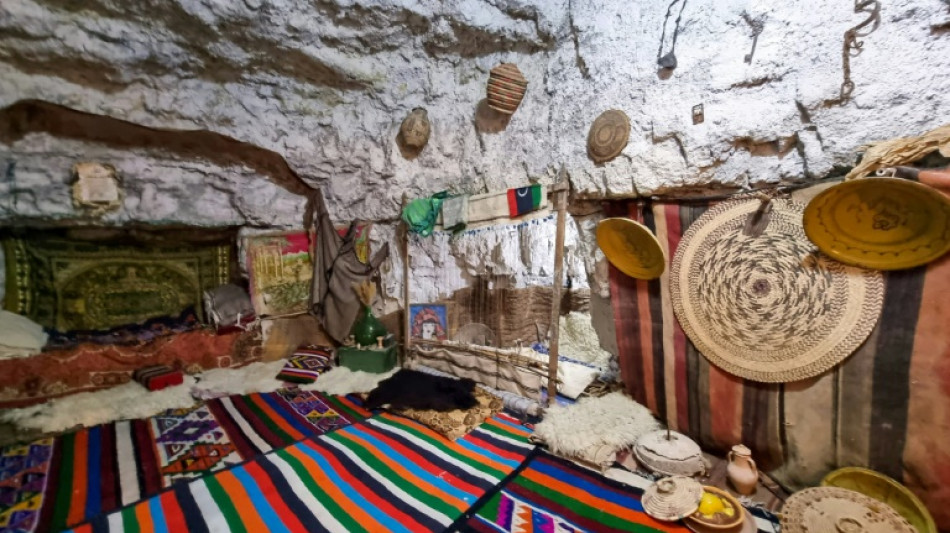
-
 Kenya's economy faces climate change risks: World Bank
Kenya's economy faces climate change risks: World Bank
-
World stocks mostly slide, consolidating Fed-fuelled gains

-
 Crypto firm Tether bids for Juventus, is quickly rebuffed
Crypto firm Tether bids for Juventus, is quickly rebuffed
-
UK's king shares 'good news' that cancer treatment will be reduced in 2026

-
 Can Venezuela survive US targeting its oil tankers?
Can Venezuela survive US targeting its oil tankers?
-
Salah admired from afar in his Egypt home village as club tensions swirl

-
 World stocks retrench, consolidating Fed-fuelled gains
World stocks retrench, consolidating Fed-fuelled gains
-
Iran frees child bride sentenced to death over husband's killing: activists

-
 World stocks consolidate Fed-fuelled gains
World stocks consolidate Fed-fuelled gains
-
France updates net-zero plan, with fossil fuel phaseout

-
 Stocks rally in wake of Fed rate cut
Stocks rally in wake of Fed rate cut
-
EU agrees recycled plastic targets for cars

-
 British porn star to be deported from Bali after small fine
British porn star to be deported from Bali after small fine
-
British porn star fined, faces imminent Bali deportation

-
 Spain opens doors to descendants of Franco-era exiles
Spain opens doors to descendants of Franco-era exiles
-
Indonesia floods were 'extinction level' for rare orangutans

-
 Thai teacher finds 'peace amidst chaos' painting bunker murals
Thai teacher finds 'peace amidst chaos' painting bunker murals
-
Japan bear victim's watch shows last movements

-
 South Korea exam chief quits over complaints of too-hard tests
South Korea exam chief quits over complaints of too-hard tests
-
French indie 'Clair Obscur' dominates Game Awards

-
 South Korea exam chief resigns after tests dubbed too hard
South Korea exam chief resigns after tests dubbed too hard
-
Asian markets track Wall St record after Fed cut

-
 Laughing about science more important than ever: Ig Nobel founder
Laughing about science more important than ever: Ig Nobel founder
-
Vaccines do not cause autism: WHO

-
 Crypto mogul Do Kwon sentenced to 15 years for fraud: US media
Crypto mogul Do Kwon sentenced to 15 years for fraud: US media
-
'In her prime': Rare blooming of palm trees in Rio

-
 Make your own Mickey Mouse clip - Disney embraces AI
Make your own Mickey Mouse clip - Disney embraces AI
-
OpenAI beefs up GPT models in AI race with Google

-
 Dark, wet, choppy: Machado's secret sea escape from Venezuela
Dark, wet, choppy: Machado's secret sea escape from Venezuela
-
Cyclone causes blackout, flight chaos in Brazil's Sao Paulo

-
 2024 Eurovision winner Nemo returns trophy over Israel's participation
2024 Eurovision winner Nemo returns trophy over Israel's participation
-
US bringing seized tanker to port, as Venezuela war threats build

-
 Make your own AI Mickey Mouse - Disney embraces new tech
Make your own AI Mickey Mouse - Disney embraces new tech
-
Time magazine names 'Architects of AI' as Person of the Year

-
 Floodworks on Athens 'oasis' a tough sell among locals
Floodworks on Athens 'oasis' a tough sell among locals
-
OpenAI, Disney to let fans create AI videos in landmark deal

-
 German growth forecasts slashed, Merz under pressure
German growth forecasts slashed, Merz under pressure
-
Thyssenkrupp pauses steel production at two sites citing Asian pressure

-
 ECB proposes simplifying rules for banks
ECB proposes simplifying rules for banks
-
Stocks mixed as US rate cut offset by Fed outlook, Oracle earnings

-
 Desert dunes beckon for Afghanistan's 4x4 fans
Desert dunes beckon for Afghanistan's 4x4 fans
-
Breakout star: teenage B-girl on mission to show China is cool

-
 Chocolate prices high before Christmas despite cocoa fall
Chocolate prices high before Christmas despite cocoa fall
-
Austria set to vote on headscarf ban in schools

-
 Asian traders cheer US rate cut but gains tempered by outlook
Asian traders cheer US rate cut but gains tempered by outlook
-
AI's $400 bn problem: Are chips getting old too fast?

-
 Oracle shares dive as revenue misses forecasts
Oracle shares dive as revenue misses forecasts
-
US stocks rise, dollar retreats as Fed tone less hawkish than feared

-
 Divided US Fed makes third straight rate cut, signals higher bar ahead
Divided US Fed makes third straight rate cut, signals higher bar ahead
-
Machado to come out of hiding after missing Nobel ceremony


Libya's underground homes wait for tourism revival
Gharyan's unique underground houses were hewn into the mountainside centuries ago, and many lie abandoned, but residents of the Libyan town are hoping tourism can help restore their heritage.
"My great-great-great-great-great-grandfather dug this yard 355 years ago," said Al-Arbi Belhaj, who owns one of the oldest houses in the mixed Berber-Arab town south of Tripoli.
His ancestor would have used a "tajouk" pickaxe to chip away at the ground before loading the rubble into a woven date-palm "gouffa" basket to carry it away, he said.
Dug deep into the arid Nafusa mountains at around 700 metres (2,300 feet) above sea level, the home would have been protected against the scorching summers that bring temperatures up to 45 degrees Celsius (113 Fahrenheit).
It would have also stayed warm throughout the often snowy winters.
The region's bedrock has a consistency that allowed the underground dwelling -- known as a damous -- to last for centuries without collapsing.
Some of the buildings are over 2,300 years old, and ancient Greek historians mentioned their existence, according to historian Youssef al-Khattali.
The area also has burial sites dating back to Phoenician times, he added.
Today, Belhaj says he is the owner of the oldest underground home in Gharyan, a town where many residents have family records and property deeds dating back centuries.
The warren of rooms dug into the rock around the courtyard once housed as many as eight large families, he said.
He was the last person to be born there, in 1967.
In 1990, like many people seeking more comfortable dwellings with running water and electricity, the family moved out of the home, but they kept ownership of it.
Now, Belhaj has renovated it and turned it into a tourist attraction.
- 'Designed to be versatile' -
While late dictator Moamer Kadhafi allowed tourists to visit the country on organised trips, visitors have been thin on the ground since his fall in a 2011 revolt, which sparked a decade of chaos.
But the region's Berber villages have continued to attract domestic tourists, and Belhaj is hoping that a return to relative stability could open the door to more visitors from Europe and elsewhere.
He charges an entry fee equivalent to a dollar for Libyans, or two for foreigners.
While some come for a cup of tea and to explore the building, others stay for lunch or spend the entire day there.
Damous structures were once common across a stretch of western Libya and eastern Tunisia -- the other side of a border only drawn up in 1886.
"The same tribes extend from Nalut to Gabes," said historian Khattali, referring to towns on the Libyan and Tunisian sides.
Their sites were carefully chosen and the buildings painstakingly excavated by hand to avoid them collapsing in the process.
In 1936, they attracted the attention of colonial power Italy, featuring in a tourist guide.
And they were not just used as homes.
"First of all, there were underground dwellings for humans and their animals, then buildings intended as places of worship," Khattali said, referring to synagogues and churches that were mostly later converted to mosques.
Some were also used as defences, he said.
"You can still make out the traces of fortifications in certain parts of the mountain, including the remains of watchtowers."
The buildings "were designed to be versatile, and they've stood the test of time," Khattali said.
"That's why they're so important in the history of Libyan architecture."
Ch.Lefebvre--CPN
